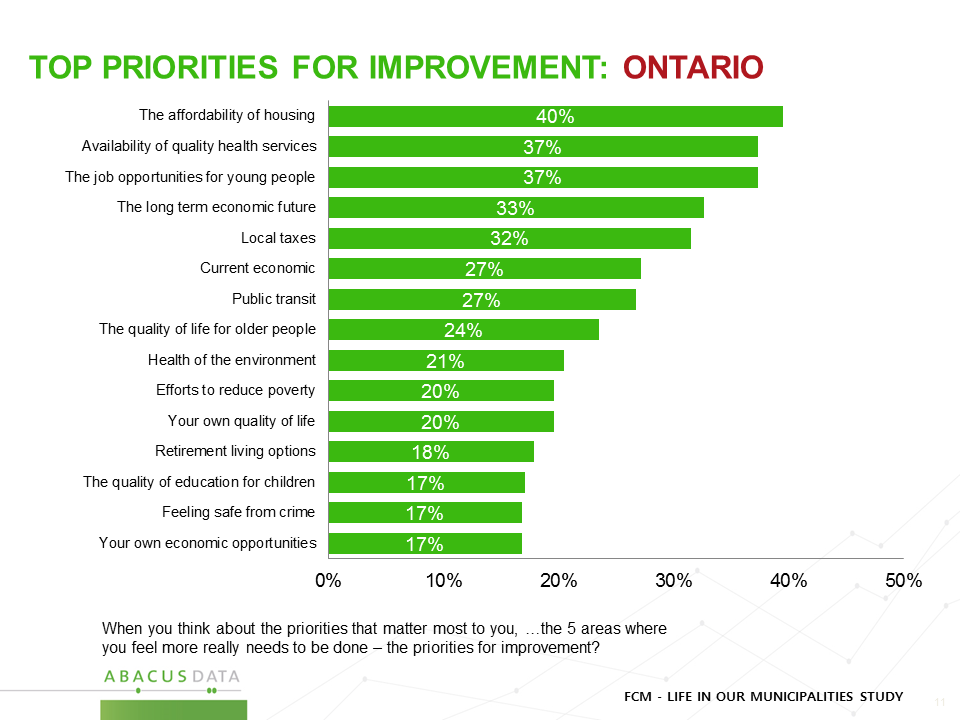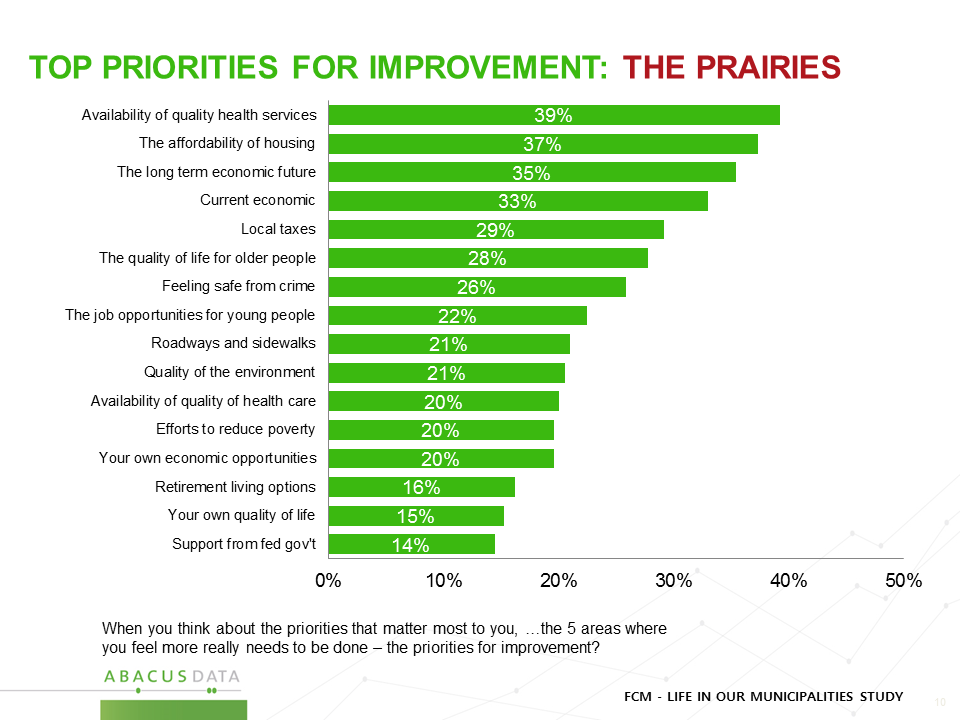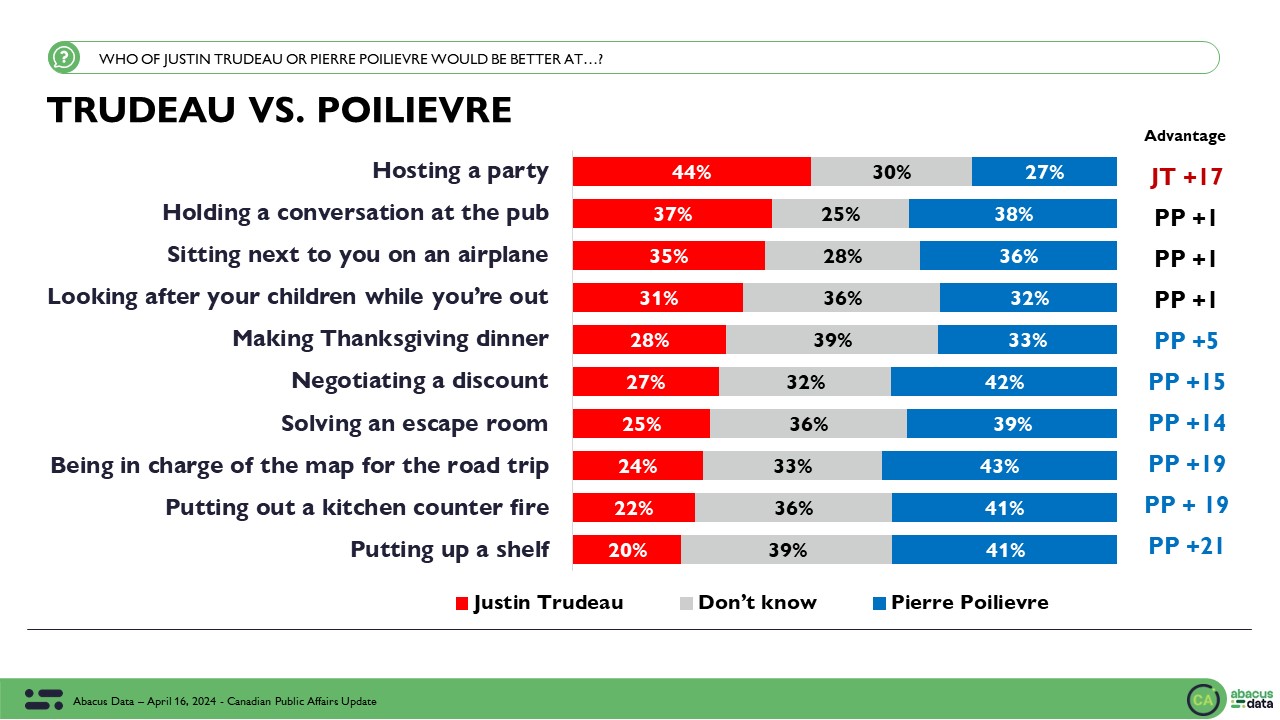Life in Canada’s Communities: What’s getting better or worse, and what the priorities should be
February 29, 2016
We like where we live, but we see more signs of pressure than improvement
Abacus recently completed an in-depth nationwide LIFE IN CANADA’S COMMUNITIES study for the Federation of Canadian Municipalities. This release is the second in a series of story lines based on this study.
COMMUNITIES FEELING SOME PRESSURES
Feeling good about the communities we live in is the norm across Canada: the large majority in our survey say they live in good place, one of the best, or the best in Canada.
However when we asked people what was getting worse or getting better across 29 different aspects of community life, we found that:
• On only 5 of the 29 items did more than 20% say that things were getting better. On 20 items more than 20% said things were getting worse.
• 32% said their quality of life was improving, double the number that said it was deteriorating.
• 20% said their economic opportunities were improving, while 24% said the opposite.
• The items where more than a fifth said things were getting better included: recreational areas and services, garbage and waste management, and public transit.
• There were 5 items where more than 40% said things were getting worse: affordability of housing, local taxes, current economic conditions and future outlook, and job opportunities for young people.



For the most part perceptions about whether things are getting better or worse in the past 5 years are fairly consistent across age groups. But there are a number of outliers.

• Albertans are far more likely to say that current economic conditions have gotten worse, at 71% compared to 46% nationally.
• Residents of the largest cities, and those in BC and Ontario are more likely to cite deteriorating housing affordability.
• When it comes to job opportunities for young people, older generations show more worry than the young.
PRIORITIES FOR GOVERNMENTS

Of the 29 items we asked respondents to identify which were the most important priorities for improvement, the 5 areas where they feel more really needs to be done. The items that rose to the top of the list were: availability of healthcare services, affordability of housing, long term economic opportunities, opportunities for young people, and local taxes.
But not all Canadians would have the same priority list:
• Those living in Canada’s largest communities are more likely to rate affordability of housing, health services, long-term economic growth and local taxes as top priorities. They are also more likely to cite public transit as a priority.
• For those in medium sized communities, health is the top priority, followed by housing affordability, long-term economic growth, and the quality of life for older people.
• In smaller towns, health services are the top priority for more people but job opportunities for young people rise to the second most chosen priority, followed by long-term economic opportunities and the quality of life for older people.



The ordering of priorities also differs depending on the region of the country one lives.
• In Atlantic Canada, 49% said job opportunities for young people was one of their top 5 priorities, higher than in any other region of the country.
• In Quebec, health services, long-term economic future and quality of education were the top priorities.
• Ontarians showed more preoccupation with affordability of housing, health care, and job opportunities for young people. Public transit was also a priority to more people than in other regions of the country.
• In the Prairies, health care, housing affordability and economic conditions were the top concerns.
• In BC, half of respondents rated housing affordability as a top priority (highest in Canada) followed by health services and the long-term economic future and jobs for young people.





THE UPSHOT
While most people are on the whole happy with the place that they live, there are clearly areas where they feel pressures have been mounting. As one might expect in a country as large and diverse as Canada, these pressure points and priorities are not identical in every part of the country or among all social groups.
That said there is more in common than not. People are nervous about rising housing costs, affordability of local taxes, current and long term economic conditions, and job prospects for young people. In some areas, housing affordability is more acute, in other areas, access to health services, public transit, or affordable education is a more pressing concern.
METHODOLOGY
Our survey was conducted online with 1,500 Canadian respondents from January 24 to January 26, 2016. A random sample of panelists was invited to complete the survey from a large representative panel of Canadians, recruited and managed by Research Now, one of the world’s leading provider of online research samples.
The Marketing Research and Intelligence Association policy limits statements about margins of sampling error for most online surveys. The margin of error for a comparable probability-based random sample of the same size is +/- 2.6%, 19 times out of 20 for each province’s sample. The data were weighted according to census data to ensure that the sample matched Canada’s population according to age, gender, educational attainment, and region. Totals may not add up to 100 due to rounding.
ABACUS DATA
We offer global research capacity with a strong focus on customer service, attention to detail and value added insight. Our team combines the experience of our Chairman Bruce Anderson, one of Canada’s leading research executives for two decades, with the energy, creativity and research expertise of CEO David Coletto, PhD.




